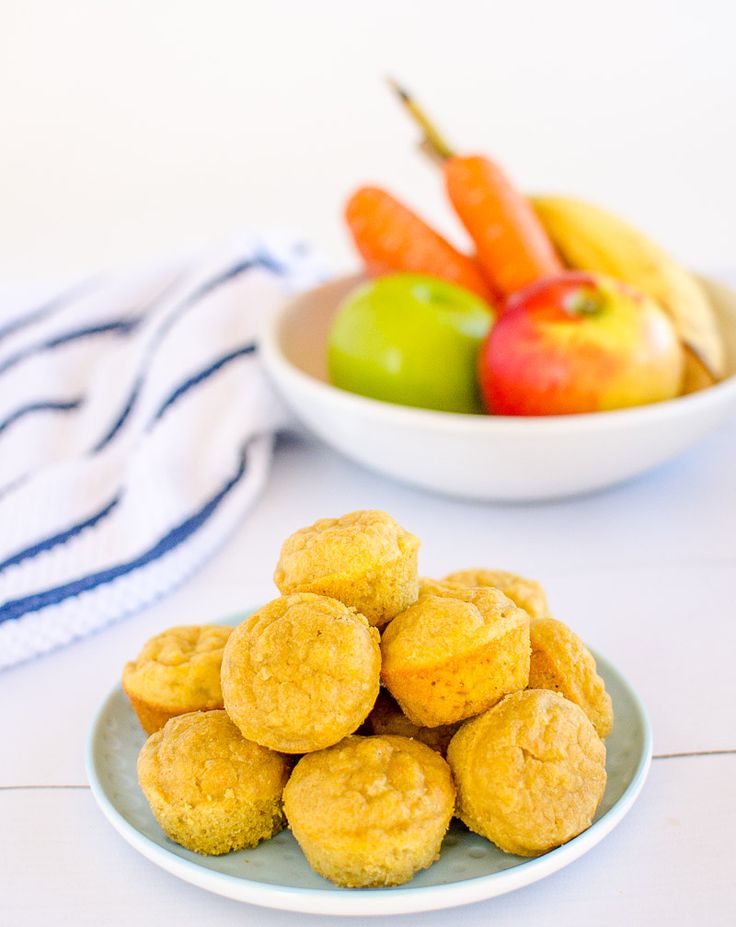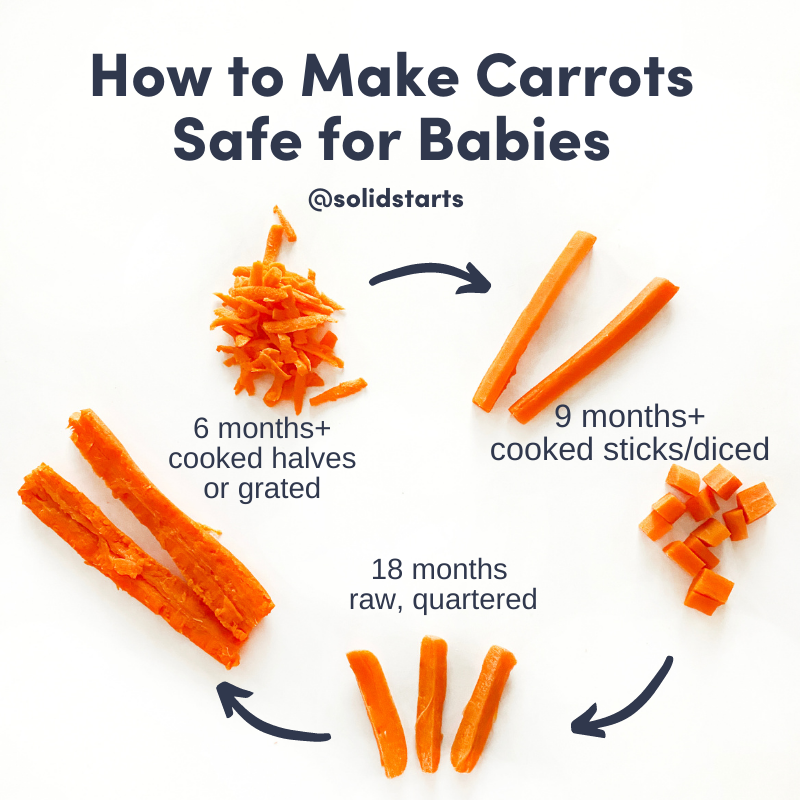Baby finger foods 8 months old
Giving Baby Finger Foods at 7-8 Months
Written by Rebecca Felsenthal Stewart
In this Article
- Month 7, Week 3
- Month 7 Week 3 Tips
Month 7, Week 3
Once your baby is a pro at eating soft mashed foods, they may be ready to move on to finger foods around 8 months. They have the dexterity to pick the food up and release it or mash it, and will become more efficient and independent as they master the pincer grip around 9 months. At that point they'll be able to use their thumb and forefinger to pick up the small chunks of food.
Your baby may grab at everything on your plate, but follow these guidelines for healthy and safe feedings.
- Start with menu items like pieces of soft cheese; small pieces of pasta or bread; finely chopped soft vegetables; and fruits like bananas, avocado, and ripe peaches or nectarines. These foods should require minimal chewing, as your baby may not yet have teeth. Do NOT let them have hot dogs, raw vegetables, nuts, meats, hard candy, or sticky textures such as nut butters that have increased choking risks at this stage.
- Introduce new foods one at a time in case there are any concers about allergies.
- Chop all foods into soft, bite-sized pieces, 1/2 inch or smaller.
- Watch out for choking hazards: Avoid round, firm foods like carrots, grapes, and hot dogs and skip anything like raw veggies and peanuts. Raisins and popcorn are dangerous for babies.
- Keep up your formula or breastfeeding schedule, but as your baby eats more solids, they’ll naturally start to take less milk. Your baby needs to start eating more solids and drinking less milk for the nutritional value at this stage.
Your Baby's Development This Week
Your baby is getting stronger and may even be moving around, whether they are sliding around on their belly in reverse, scooting on their behind, or actually crawling forward. If you haven’t childproofed your house already, don’t wait any longer!
You may notice these growing signs of motor development:
- Your baby is probably now able to sit on their own for several minutes, without using their hands for support and they may be able to get up into a sitting position all by themselves.

- While you offer them support, they should be able to bounce up and down, and possibly even pull up to a stand.
- Their little hands are increasingly agile -- they are getting better at passing a toy back and forth from one to the other.
You might wonder about:
- Their vision. Your baby should be able to see nearly as far as an adult by now and can track moving objects with their eyes.
- Stranger anxiety. You’re not imagining it: They may fear new people and situations. So give them time to warm up and reassure them if they are upset.
- What they can understand. Your baby might comprehend more than you realize, so it’s important to keep talking to them about everything you’re doing and try to be consistent about the words you use for familiar objects.
Month 7 Week 3 Tips
- If food allergies run in the family, talk to your pediatrician about introducing highly allergenic foods like peanuts and eggs.

- Fried foods are not good choices for babies. If you offer them at all, do so rarely.
- Avoid feeding your baby juice unless it is fresh-squeezed.
- By now, your baby’s diet should include grains, fruits, vegetables, and meats, and they should be eating two to three meals a day.
- In addition to rice, barley, or oat cereal, you can introduce grain products your baby can grab, such as toast, crackers, and dry cereal. Avoid any colorful, sugary cereals.
- Sit baby in their high-chair for feeding time. If they eat finger foods while crawling around, they are more likely to choke.
- You’re not done with breast feeding or bottle feeding. Your baby is starting the transition, but breast milk and formula are still key.
- Pureeing or mashing vegetables may make them easier for your baby to eat when they are first transitioning from a liquid diet to solids.
13 Best Finger Foods for Baby
Introducing finger foods for baby is an exciting and nerve-racking time. Between the mess, possible allergies and potential choking hazards, it’s enough to give some parents white knuckles as they hover over the high chair. But while you should certainly exercise caution, there are lots of great baby finger food ideas that will make mealtime fun and nutritious, and let your growing child practice the important art of self-feeding.
Between the mess, possible allergies and potential choking hazards, it’s enough to give some parents white knuckles as they hover over the high chair. But while you should certainly exercise caution, there are lots of great baby finger food ideas that will make mealtime fun and nutritious, and let your growing child practice the important art of self-feeding.
In this article:
When can babies eat finger foods?
Baby finger food safety
How to introduce new finger foods for baby
Best finger foods for baby
When Can Babies Eat Finger Foods?
There’s no hard and fast rule in terms of when babies can start eating finger foods, says William Dietz, MD, PhD, director of the Sumner M. Redstone Global Center for Prevention and Wellness at the Milken Institute School of Public Health at the George Washington University in Washington, DC, and co-editor of the American Pediatric Association’s (AAP) Nutrition: What Every Parent Needs to Know. Rather than focusing on baby’s age, says Dietz, “the first indicator you should look for is that the baby is interested.” So how can you tell when baby’s interest is piqued? Reaching for the food as you’re feeding her, grabbing the bowl or spoon, putting the spoon in her mouth and fussing when she sees you eat (because she wants in!) are all signs your child may be ready. “Babies generally want to feed themselves,” Dietz says. “That’s a normal drive.”
Rather than focusing on baby’s age, says Dietz, “the first indicator you should look for is that the baby is interested.” So how can you tell when baby’s interest is piqued? Reaching for the food as you’re feeding her, grabbing the bowl or spoon, putting the spoon in her mouth and fussing when she sees you eat (because she wants in!) are all signs your child may be ready. “Babies generally want to feed themselves,” Dietz says. “That’s a normal drive.”
Being able to sit independently is another good clue that babies are physically ready to try finger foods, says Susan M. McCormack, MA, senior speech language pathologist at Children’s Hospital of Philadelphia and a board-certified specialist in swallowing and swallowing disorders. If they can sit up in the high chair, then they might be ready to try their hand at finger foods.
Some guides suggest waiting to introduce baby finger foods until your child has mastered a pincer grasp—the ability to pick up small objects between the thumb and forefinger—but Dietz says this isn’t totally necessary. “Initially when children start to feed themselves, they don’t have a pincer grasp,” he says. “So they’re using their whole hand and putting their hand in their mouth. And that’s fine.”
“Initially when children start to feed themselves, they don’t have a pincer grasp,” he says. “So they’re using their whole hand and putting their hand in their mouth. And that’s fine.”
If you’re waiting for your infant to sprout teeth before moving on from purees, think again. “Babies don’t need teeth to learn to eat solids and learn to chew,” McCormack says. Those strong little gums are perfectly capable of mashing up soft solids—if you’ve ever let baby teethe on your finger, then you have some idea of just how powerful they are!
Baby Finger Food Safety
When choosing the best finger foods for baby—whether you’re starting at 6 months or 9 months—experts agree that it’s best to begin with small pieces of soft food that dissolve easily.
As your infant grows and becomes comfortable eating finger foods, you can branch out, McCormack says. “As a baby develops better tongue patterns to control food pieces as well as more mature chewing, he can better ‘chew’ the foods that break apart, like pieces of fruits and vegetables. A one-year-old can also bite off pieces of food that a 6-month-old can’t.”
A one-year-old can also bite off pieces of food that a 6-month-old can’t.”
Avoid giving baby finger foods that are large, sticky or don’t dissolve easily, because they’re potential choking hazards, Dietz warns. He suggests steering clear of foods like hot dogs, carrots, nuts, grapes, popcorn, candy and globs of peanut butter.
Another thing to keep in mind when you’re picking out the best finger foods for babies is that a lot of adult foods—particularly snacks—can be super salty. “Often parents will doctor a food so it appeals to their tastes, and their taste may have bigger amounts of sodium than a baby’s taste,” Dietz says. When preparing food for baby, leave out the salt whenever possible. (You can always add it separately to your portion if you’re cooking for the family).
How to Introduce New Finger Foods for Baby
When babies first start on finger foods, breast milk and formula will still be their main source of nutrition, followed by purees. You should continue to spoon-feed your child initially, “but during the feeding process, they should also be allowed to feed themselves,” Dietz says. Put some finger food on her high-chair tray and let her try to get it into her mouth in between the spoonfuls of food you’re feeding her. If she gets really frustrated, go ahead and help her out.
Put some finger food on her high-chair tray and let her try to get it into her mouth in between the spoonfuls of food you’re feeding her. If she gets really frustrated, go ahead and help her out.
Most important, follow your child’s cues and “let your baby be the guide,” McCormack says. If he doesn’t respond positively, take a step back and try again later. But keep in mind that babies often crinkle up their faces when they try something new, which can look like they don’t like something, Dietz says. It can take up to 20 times before they’re used to certain foods. “Parents shouldn’t force food, but they should be persistent in offering,” Dietz says.
McCormack also suggests easing into finger foods by offering thicker purees with a bit of texture to them. “Try alternating bites of the smooth puree with a slightly thicker or mashed food to help your baby get used to the new textures in her mouth,” she says.
Remember, too, that this is a messy process. Parents might want to lay newspaper or an easy-to-clean vinyl tablecloth on the floor, since it’ll be a while (like, years) before your kid manages to get more food in his mouth than on the floor, Dietz advises.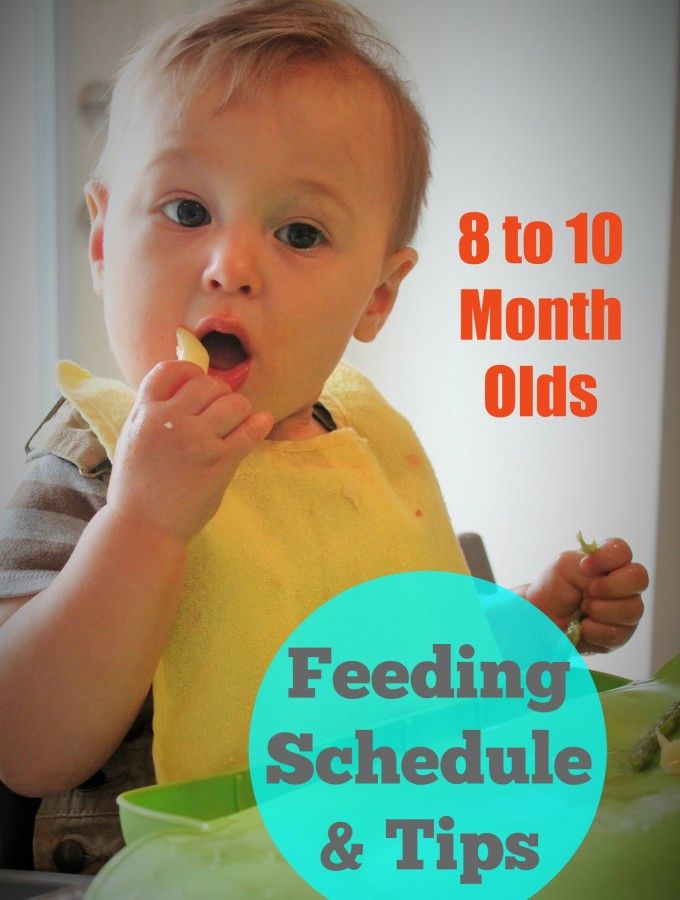
Finally, never leave baby unattended while she’s eating, and keep an eye out for signs of choking. It may be tempting to hold off on introducing finger foods until your child is older, but helping baby develop this skill has multiple benefits, McCormack says, including “development of independence, fine motor skills and self-feeding skills, as well as development of oral patterns to support texture progression.” Whether you start baby finger foods at 6 or 9 months, just follow baby’s lead and let him have fun with it.
Best Finger Foods for Baby
If you’re looking for baby finger food ideas, think about options that are soft, small and easily gummed. Here are a few of the best finger foods for baby to get started—including finger foods for baby with no teeth! While the same finger foods are as appropriate for a 6-month-old as they are for a one-year-old baby, you can begin to offer slightly larger pieces that they can bite off themselves as they become more confident. Stick with these healthy options, and you’ll start baby off on the right path for healthy eating.
Stick with these healthy options, and you’ll start baby off on the right path for healthy eating.
Image: The Bump
1. Puffs and dry cereal. Puffs and O-shaped dry cereal are some of the most popular first finger foods for good reason: They let baby practice the pincer grasp by picking up one at a time. And as McCormack explains, they also “mix well with saliva and are easy for the infant to manage in their mouth without choking.”
2. Teething biscuits and lightly toasted bread. Teething biscuits and small pieces of lightly toasted bread are another great starter finger food, since they soften quickly. Just note that some breads can turn gummy and stick in baby’s mouth; lightly toast the bread and cut into very small pieces to avoid a choking hazard. As baby gets older (around 9 to 12 months), you can offer slightly larger pieces or serve bread topped with mashed banana or avocado, or a super-thin layer of hummus or peanut butter.
3. Scrambled eggs. Doctors used to advise waiting to introduce eggs, but the AAP now recommends early exposure to potentially allergenic foods. Which is great news, since scrambled eggs are an ideal early finger food! Keep your love of runny yolks to yourself for now, however, and cook those eggs thoroughly, cut into small pieces and avoid adding salt.
Scrambled eggs. Doctors used to advise waiting to introduce eggs, but the AAP now recommends early exposure to potentially allergenic foods. Which is great news, since scrambled eggs are an ideal early finger food! Keep your love of runny yolks to yourself for now, however, and cook those eggs thoroughly, cut into small pieces and avoid adding salt.
4. Soft fruit. Very ripe fruit is naturally soft, making them some of the best finger foods for babies. Ripe banana, peach, watermelon, raspberries, blueberries and cantaloupe cut into small pieces are all great finger food options.
5. Avocado. A rich source of omega-3 fatty acids—which can help boost baby’s brain development—avocados are, like puffs, often one the first baby finger foods, even when your little one has no teeth. Be warned: Avocado can get messy fast, but it’s well worth it (and can result in some hilarious pics for the baby album).
6. Pasta. Though recipes often recommend cooking pasta al dente, when it comes to feeding baby, you’ll want to slightly overcook it so it’s nice and soft.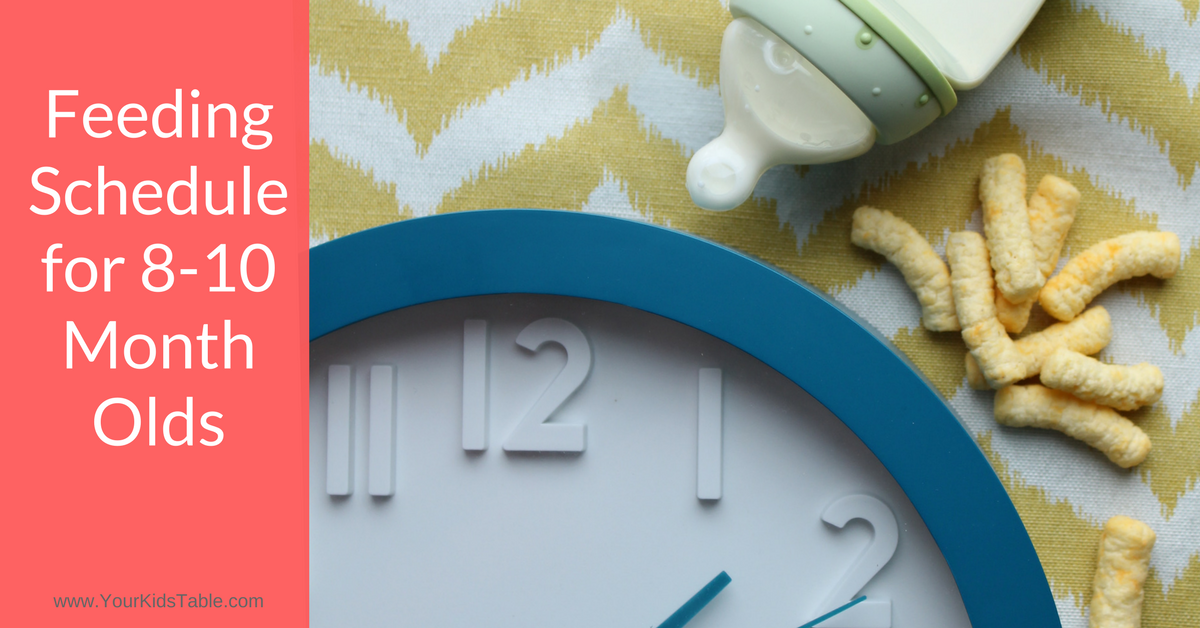 To start, try small pasta shapes like orzo or mini shells, or cut up fusilli or penne. Initially serve it plain, but as baby is introduced to more foods you can toss the pasta in a little butter, olive oil or low-sodium tomato sauce.
To start, try small pasta shapes like orzo or mini shells, or cut up fusilli or penne. Initially serve it plain, but as baby is introduced to more foods you can toss the pasta in a little butter, olive oil or low-sodium tomato sauce.
7. Tofu. Whether cooked or uncooked, tofu is a wonderful plant-based source of protein and a perfect finger food for babies. Opt for firm tofu, which is still quite soft, as opposed to soft or silken tofu, which will likely fall apart in baby’s hand and frustrate her.
8. Cooked vegetables. Though it will be a while before baby can hit the crudités platter, cooked vegetables make excellent baby finger foods. To get the most nutrients out of your vegetables, steam or roast them until soft, and, of course, cut them into small pieces. Try sweet potato, carrot, broccoli, cauliflower or beets (opt for yellow beets for less mess) to start. As baby gets bigger, you can offer steamed carrot sticks or peeled, roasted sweet potato wedges.
9. Cheese. If baby has shown no signs of a dairy allergy, then it’s perfectly safe to introduce soft cubes of cheese as early as 6 months. Opt for small bites of a pasteurized cheese that’s soft but not overly sticky or stinky, like Monterey Jack or cheddar.
10. Beans. Looking for more protein-rich, vegetarian baby finger foods? Try beans. Opt for canned, low-sodium beans for convenience, or soak and cook dry beans yourself to save money (they’ll freeze well too!). When first introducing beans, smash them just a bit between your fingers before serving to baby.
11. Homemade muffins. While store-bought muffins are often loaded with sugar, there are plenty of healthy muffin recipes out there. Use whole-wheat flour, sweeten with applesauce instead of sugar and add healthy ingredients like mashed banana or grated zucchini. Bake in a mini muffin tin or use a standard-size tin, and, once baked, break off into small pieces for baby.
12. Meat. After soft foods, diced chicken breast and ground beef are pediatrician-approved next-stage finger foods for baby. Just make sure they’re thoroughly cooked and cut into very small pieces.
13. Fish. Fish is another allergenic food that doctors now say can be introduced before baby is a year old. Be sure it’s thoroughly cooked, and opt for a low-mercury fish like flounder, cod or salmon. Most important, make sure to remove any tiny bones.
Please note: The Bump and the materials and information it contains are not intended to, and do not constitute, medical or other health advice or diagnosis and should not be used as such. You should always consult with a qualified physician or health professional about your specific circumstances.
Plus, more from The Bump:
Baby-Led Weaning Basics
Why Variety Matters in Baby’s First Foods
The Dos and Don’ts of Homemade Baby Food
Finger food - Encyclopedia Baby food
Viktoria Levchuk©
Finger food is baby food prepared in the form of pieces of boiled soft food so that the child can independently take it and transfer it to the mouth, chew it or swallow it without anyone help and any problems.
Finger food is a fun way to encourage the development of motor coordination and skills for biting, chewing and self-feeding. Food in pieces should be easy to grasp by children's fingers and long-term storage, and should not contain bones or seeds. nine0007
As soon as the child begins to take food with his fingers and put it into his mouth with reasonable hand-eye coordination, then the fun begins! Let your child experiment with soft snacks such as a banana or peach that can be “hand-mashed” to the right consistency. The more a child experiments with finger food, the faster he will masterfully feed himself.
Finger food helps keep a child's food interest. As soon as he begins to feed himself on his own, then new taste horizons open up for him. What child refuses to try to bring the product to his mouth on his own, even if he didn’t really like it before. nine0007
Contents:
Very often mothers think at what age should they give finger food to their baby.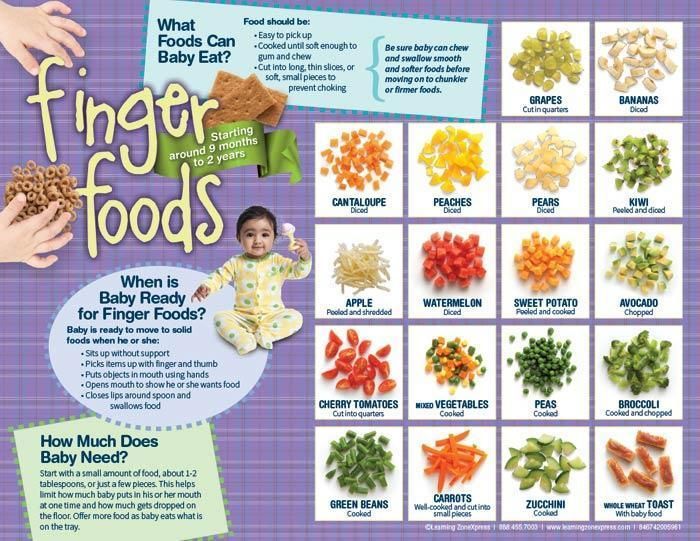
Honestly, even for me it's a difficult question. It's just that sometime between eight and nine months, the baby began to eat small pieces of food. The change in the consistency of food by age is very well described in the WHO recommendation, so it should be guided by.
Food consistency up to a year. Click on me!!!
However, you should not do it blindly and try to feed the baby in pieces at a certain age, perhaps he will not be ready yet. Children are all different, some want food in pieces, almost from the beginning of complementary foods, others are not ready for lumpy food for up to a year or more. Therefore, any decision on finger food is made based on the child and his readiness. An excellent preparation for finger food is a nibbler, which will prepare the child for lumpy food. nine0007
The child has no teeth
Click on me!!! A child's gums are incredibly strong, as is the tongue, so the number of teeth is not an indicator of whether to give finger food or not. If the decision has been made to start complementary foods and the baby is doing well with mashed foods, then you can safely start giving small pieces of soft food when the baby is ready for it. At this stage, it is important to let the child try to eat food of a different consistency, more complex, in order to train the maxillofacial apparatus. Thus, the child gradually prepares for the full chewing of food with the help of the entire jaw, teeth and tongue. nine0007
If the decision has been made to start complementary foods and the baby is doing well with mashed foods, then you can safely start giving small pieces of soft food when the baby is ready for it. At this stage, it is important to let the child try to eat food of a different consistency, more complex, in order to train the maxillofacial apparatus. Thus, the child gradually prepares for the full chewing of food with the help of the entire jaw, teeth and tongue. nine0007
Knowing if finger food is safe for a child
A good rule of thumb to help prevent choking is to avoid anything hard (e.g. raw carrots), round (e.g. whole grapes), sticky (e.g. , spoon of nut butter) or too much gummies (such as gummies). At first, the child is given pieces of food in the form of sticks, which can be easily clamped in the child's chick, later, when the child begins to control the finger grip better, you can move on to cubes.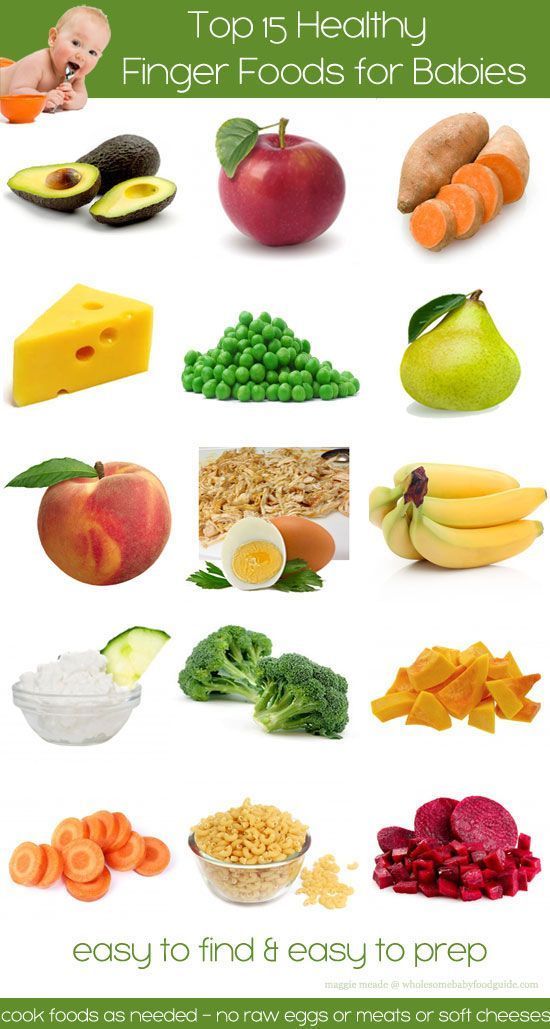 At first, finger food should be soft, boiled and melt in your mouth. As a child learns to manage with such products, it is possible to complicate the task and switch to fresh soft foods, etc. nine0007
At first, finger food should be soft, boiled and melt in your mouth. As a child learns to manage with such products, it is possible to complicate the task and switch to fresh soft foods, etc. nine0007
Foods that squeeze easily between fingers are good for older children and for younger children. Around 16-18 months, many babies are ready for more complex textures. During this period, cutting food into pea-sized pieces is also a good idea - many babies tend to put large pieces of food in their mouths, so small cubes are used to avoid choking. We always adjust the sizes of products according to the age and eating experience of our own child. nine0007
Usually the first finger food is biscuits or baby biscuits, which are very soft and dissolve easily in the mouth. The baby first sucks it, procrastinates, and learns to roll pieces of food in the mouth with the help of the tongue. A little later, when the teeth appear, you can give the product a little harder, for example, a soft apple, some parents play it safe and give a baked apple without a peel. Later, as new foods, vegetables and fruits are introduced into complementary foods, they are offered in the form of finger food, such as boiled broccoli or cauliflower. In general, the child can be offered almost all products in the form of finger food, which is introduced into baby food. nine0007
Later, as new foods, vegetables and fruits are introduced into complementary foods, they are offered in the form of finger food, such as boiled broccoli or cauliflower. In general, the child can be offered almost all products in the form of finger food, which is introduced into baby food. nine0007
Should the product be peeled or not?
We give an apple to a child without a peel. The first finger foods in the form of vegetables and fruits are given without skins. Yes, the skin of many fruits and vegetables contains valuable nutrients. It is often recommended to leave the skin on in order to take full advantage of the nutrients contained in the product. But removing the top layer from fruits and vegetables helps reduce the amount of pesticides that may be in the product. Peeling fruits and vegetables helps avoid choking hazards due to the rough texture of the skins. The peel also usually sticks to the palate in the child's mouth, thereby hindering him, and can be there for a long time, and when the child swallows, the probability of choking in the absence of an adult nearby is higher. Getting rid of the skin at the beginning of complementary foods also helps prevent disorders
Getting rid of the skin at the beginning of complementary foods also helps prevent disorders
digestion. And we also take into account that there are some vegetables and fruits, such as pumpkin and avocado, which need to be peeled, because their peel is really inedible. It is not worth getting rid of the product from the peel for a long time, only at first. Usually the first couple of months of complementary foods and exposure to finger food. Then the product with the peel is given to the child in the presence of an adult, after which it is advisable to check the baby's mouth to see if he swallowed everything. Forcibly open your mouth should not be, play the game "Show your tongue or where are your teeth." By the age of 1.5, the child copes well with the peel of fruits and vegetables, if it is too rough, then it easily spits it out. nine0007
Choking
The presence or absence of teeth does not mean that a child can chew.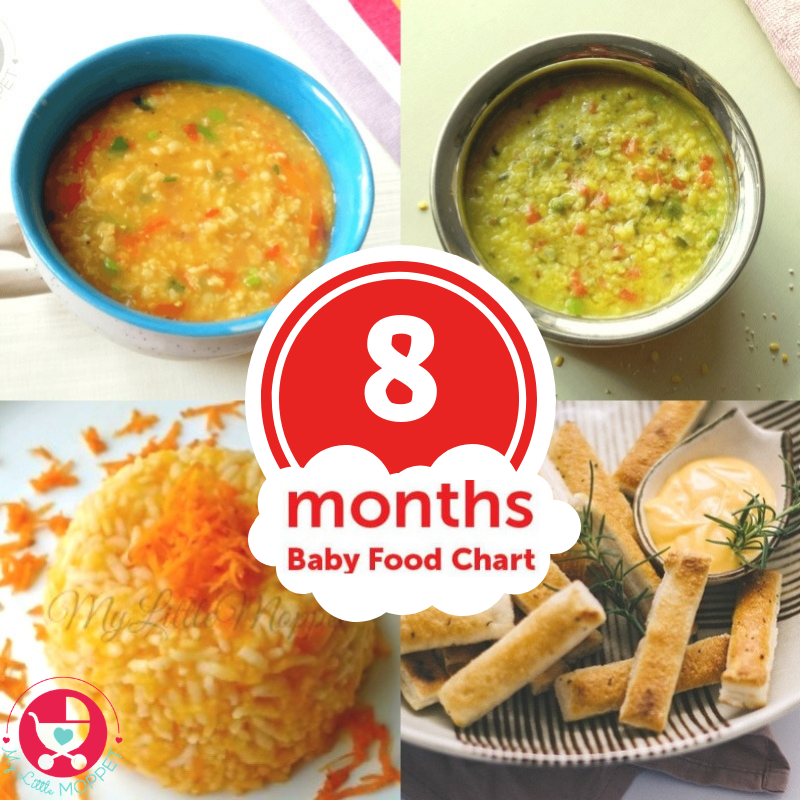 Sometimes children can bite off a piece of food, try to swallow it whole and choke, so never leave a child alone while eating. Some children can store food in their mouths like hamsters, so we always check to make sure the child has swallowed everything before leaving the kitchen. You can read the article on suffocation here.
Sometimes children can bite off a piece of food, try to swallow it whole and choke, so never leave a child alone while eating. Some children can store food in their mouths like hamsters, so we always check to make sure the child has swallowed everything before leaving the kitchen. You can read the article on suffocation here.
Our finger foods
At first I gave biscuits to my first child, later I switched to a fresh apple, mostly fresh fruits, he sucked and procrastinated them more than he ate. Later, food appeared in the form of a toy, i.e. we crumbled it, crushed it, and sometimes something got into our mouths. However, since breast milk is always given at the end of complementary foods, I was not too worried about whether the baby was full or not. nine0007
With the second child, finger food was a gradual transition from the nibbler. We used it for about a month, then I ventured to give the first pieces of food. But to be honest, the child himself tried the first pieces of food, namely, he stole an apple and took a bite. The first experience of finger food is always scary, because at first the child often coughs and spits out food, he is learning, so it is important to be with the child, if something goes wrong, then the parent will be able to provide first aid. I remind you that the child is suffocating quietly, not a single sound. If he coughs, clears his throat, then everything is within the normal range, you need to help get rid of the food that interferes. nine0005 Rules for helping with choking know before introducing finger food into complementary foods. It is imperative to look and study, and then give a new consistency of complementary foods.
The first experience of finger food is always scary, because at first the child often coughs and spits out food, he is learning, so it is important to be with the child, if something goes wrong, then the parent will be able to provide first aid. I remind you that the child is suffocating quietly, not a single sound. If he coughs, clears his throat, then everything is within the normal range, you need to help get rid of the food that interferes. nine0005 Rules for helping with choking know before introducing finger food into complementary foods. It is imperative to look and study, and then give a new consistency of complementary foods.
Of course, at first, only one type of finger food is placed in front of the baby, later a plate is bought, divided into three to five sections, which is filled with finger food. The baby is already given a choice of what to eat, so you can easily determine the taste preferences in nutrition.
Finger food quick hacks
- The first finger food should be well kneaded between the gums.

- Food in pieces should be age appropriate - do not offer whole eggs to an 8 month old baby .
- If the child cannot raise his head and sit up without help, do not offer him finger food.
- The child should always sit in an upright position, not walk, especially at the first meeting, when he is offered baby food in the form of pieces, to avoid suffocation. nine0074
- NEVER leave your child unattended when serving finger food.
Examples of finger food
The first finger food is a biscuit or a baked apple. Those. food that does not need to be chewed, it melts easily in the mouth without additional help from the child. You can start with foods that have been well received by the child in a pureed form on a spoon, serving them in convenient cubes or pieces - the size of a pea for harder items, the size of a stick or wedge for softer foods. nine0007
Examples of finger food are:
Click me!!!- pieces of soft bread or crackers
- Soft cheese, Chedder or Mozarella
- Banana
- Ripe pear without peel
- Ripe soft green apple without a peel, the first time you can give boiled
- Boiled cabbage
- .
 carrots
carrots - Boiled potatoes
- Boiled green peas
- Boiled pumpkin
- Boiled fish
- Boiled meat in the form of meatballs
- Pasta
- Quail eggs, etc.
*All products must be familiar to the child or introduced into complementary foods.
Finger Foods to Avoid
When it comes to feeding your baby with morsels, the biggest problem is preventing choking. So we do not allow him to eat anything without the presence of parents or any adult nearby. And we exclude any food that can get stuck in the child's airways:
Click me!!!- Popcorn,
- Nuts, peanuts,
- raisins and other dried fruits,
- raw vegetables (e.g. carrots),
- grapes,
- Cherries without bones, hard fruit and vegetables with a peel of
- Zhevaliy Confinctions
- popcorn, pretzels, corn chips and other snack foods
- marshmallows, etc.
Most doctors do not recommend these foods until the child can eat them safely - around 4 years (although it depends on the child, closer to 3 or 5 years). nine0007
nine0007
Finger menu for children: age recommendations and examples of dishes
Home Children "Finger" food: at what age to give the baby and what dishes to cook
Any food in the form of pieces that a child can independently take in his hand and easily eat is called "finger" food. Such nutrition is a great pleasure for the baby and a very important step towards his independence. In addition, "finger" food helps the baby develop fine motor skills and coordination. Therefore, it is important to figure out how to properly introduce such healthy food into the children's diet and from what foods to prepare interesting treats for the baby. nine0007
At what age can finger food be given to a child?
You will know when your baby is ready for finger food. The baby can already eat without outside help if:
- starts snatching the spoon from your hands with which you feed him;
- looks into the adults' plate with interest.

According to experts, this usually occurs at the age of 8-9 months.
Pay attention! Some parents introduce finger foods as early as 6 months of age. They begin to teach the baby to feed on their own not with a spoon, but with their fingers, allowing the baby to take soft pieces of food and chew. nine0007
Don't be surprised if at first the child takes the food rather clumsily in the palm of his hand and brings it to his mouth. Over time, he will master a new fine motor skill and understand how to properly hold food with his thumb and forefinger.
How do you offer finger food to your child for the first time?
If your baby eats in a high chair, place four or five finger-sized pieces on the table. Perhaps it will be more interesting for the baby to take food from the dishes - then use an unbreakable plate. When the child has eaten everything, add a few more slices of food. nine0007
Pediatricians recommend that parents feed their babies in a special high-backed highchair rather than in a car seat or stroller. So you will not be afraid that the child may choke on food. And the baby will very quickly get used to the fact that the high chair is a place for eating.
So you will not be afraid that the child may choke on food. And the baby will very quickly get used to the fact that the high chair is a place for eating.
What are the best foods for finger food?
What should be taken into account by a mother who has decided to introduce finger food to her baby?
- Even if your child has a good appetite, he still has very few milk teeth. Therefore, it is important at first to give the baby foods that are easy to chew on the gums or dissolve in the mouth. After the baby is one year old, you can already offer him more solid pieces of food. nine0074
- Put a wide variety of foods on the baby's table: while feeding, the baby learns to distinguish food by structure, color and aroma.
- Resist the temptation to give your little one sweets, such as cookies and cakes, or foods that are too fatty, such as cheese puffs and chips. A child needs nutrient-dense food, not empty calories.
- Try to offer your baby food that is comfortable for him to take with his fingers.
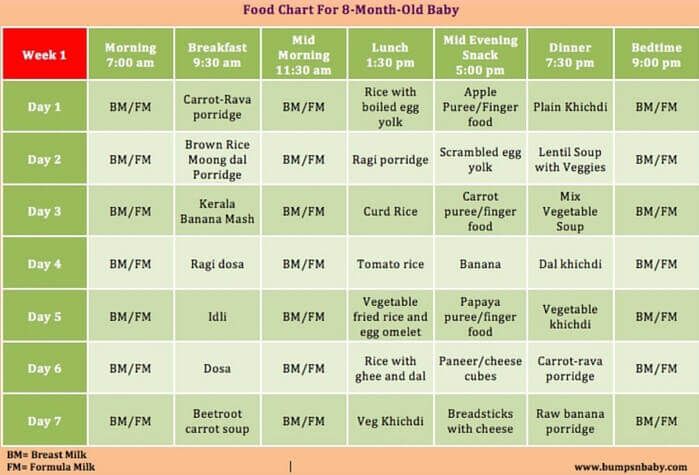 But never forget the danger of suffocation! Cook vegetables until they are completely soft, and cut absolutely all foods into small pieces. Even a grape is still too big for a child and can be dangerous. nine0074
But never forget the danger of suffocation! Cook vegetables until they are completely soft, and cut absolutely all foods into small pieces. Even a grape is still too big for a child and can be dangerous. nine0074 - Be sure to choose foods that are age appropriate. Previously, experts believed that eggs, fish, or peanut products should not be given to young children because of the increased risk of food allergies. But recent studies by experts from the American Academy of Pediatrics have shown that allergic reactions have nothing to do with the early introduction of these products into the children's diet.
Important! Peanut butter is still a banned product in baby food. The sticky texture of such food carries a potential choking hazard. nine0074 - Some pediatricians advise mothers to be very careful when introducing new foods to their baby. If you suspect that a child may be allergic to certain types of food, introduce them into the diet one by one and monitor the condition of the baby.

Options for the perfect finger food
If you use your imagination, you can come up with a lot of dishes for a baby that he can eat without the help of adults. To make it easier for you, we have compiled a whole list of "finger" snacks:
- ready-to-eat oatmeal in the form of rings or any other low sugar;
- small slices of toast or bagels - if you spread them with vegetable puree, you get a healthy snack for the crumbs;
- small pieces of banana or other ripe and pitted fruit. Mango, plum, pear, peach, melon or watermelon are perfect;
- small cubes of soy or other soft cheese;
- well-cooked pasta coils, cut into pieces; nine0074
- hard-boiled egg slices;
- pieces of boiled prunes;
- small slices of vegetables cooked until soft: carrots, peas, zucchini, potatoes;
- small florets of broccoli or cauliflower;
- pea-sized pieces of soft meat - boiled chicken or turkey, ground beef.

Conclusion
As you can see, finger food has many benefits and is very easy to prepare. Do not miss the moment when your baby is ready for such nutrition - it is very important for his development. Be prepared for the fact that the baby can get dirty with “finger” food or drop it on the floor. Clean up after the baby in time, and let him continue to have fun during the meal, while training fine motor skills. nine0007
SOURCES
AAP. Getting started with solid food. American Academy of Pediatrics. https://www.healthychildren.org/English/ages-stages/baby/feeding-nutrition/Pages/Switching-To-Solid-Foods.aspxAmerican Academy of Pediatrics. The impact of early dietary interventions on the development of atopic disease in infants and children: the role of maternal dietary restriction, breastfeeding, timing of complementary foods, and hydrolyzed formulas. Pediatrics 121(1): 183-91. http://pediatrics.aappublications.









